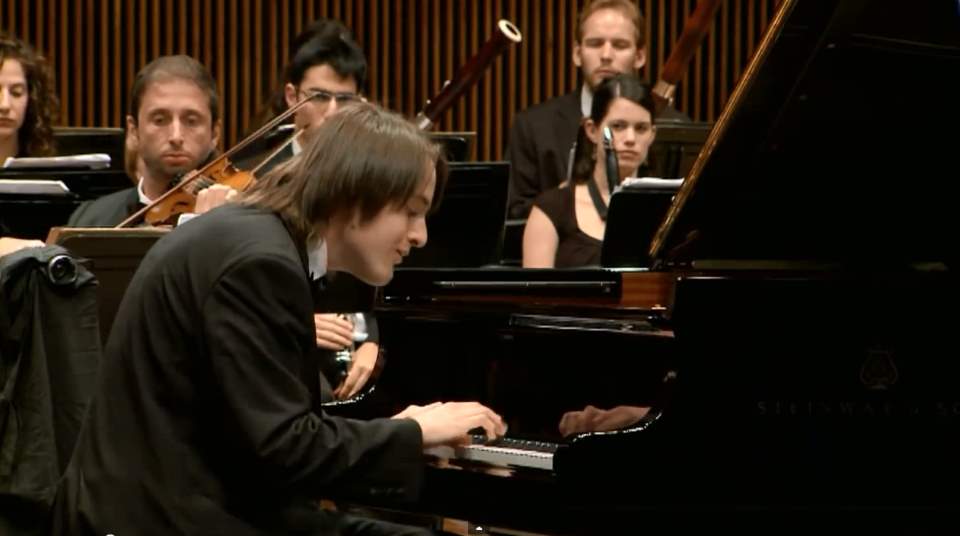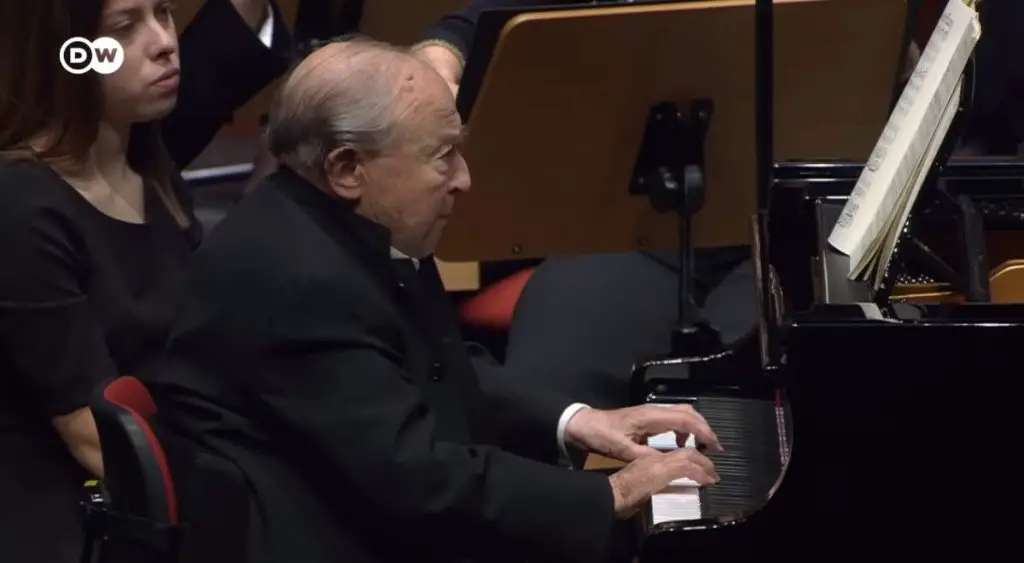Accompanied by the Netherlands Symphony Orchestra (The orchestra was previously known in Dutch as Orkest van het Oosten (literal translation “Orchestra of the East”), Croatian classical pianist Dejan Lazić performs Wolfgang Amadeus Mozart’s Piano Concerto No. 23 in A major (K. 488). Conductor: Jan Willem de Vriend. Recorded live on September 4, 2016, at the Concertgebouw, Amsterdam. An HD video Published by the Avrotros Klassiek.
Mozart’s Piano Concerto No. 23
Mozart’s Piano Concerto No. 23 in A major, K. 488, is one of his most celebrated works, exemplifying his mastery of the Classical concerto form. Composed in 1786 during a particularly prolific period in Mozart’s life, this concerto is marked by its lyrical beauty, elegance, and emotional depth. Written for a smaller orchestra, including strings, woodwinds, and horns, it creates a more intimate and refined sound compared to some of Mozart’s grander concertos.
The concerto is known for its melodic richness and the seamless interplay between the piano and orchestra. Unlike some of his earlier concertos, where the piano often dominates, No. 23 features a more balanced dialogue between the soloist and the ensemble. The orchestral accompaniment is subtle and supportive, allowing the piano to shine while still contributing significantly to the overall texture and emotional impact of the piece.
Mozart’s use of the A major key lends the concerto a warm and bright character, but it is also tinged with moments of introspection and melancholy, revealing the emotional complexity typical of his mature works. The concerto is often described as being both joyful and poignant, capturing a wide range of human emotions with its exquisite melodic lines and delicate harmonies.
The cadenzas, traditionally improvised or composed by the performer, are integral to the concerto, showcasing the pianist’s virtuosity and interpretive skill. Mozart himself, a renowned pianist, likely performed this concerto, infusing it with his own sense of expression and technical brilliance.
Piano Concerto No. 23 stands out not only for its technical demands but also for its expressive depth, making it a favorite among pianists and audiences alike. It is a testament to Mozart’s ability to blend formal sophistication with profound emotional resonance, ensuring its place as a timeless masterpiece in the piano concerto repertoire.
Movements
1. Allegro in A major and common time
The first movement of Mozart’s Piano Concerto No. 23 is an Allegro that radiates warmth, elegance, and subtle emotional complexity. It opens with a gentle, lyrical theme introduced by the orchestra, setting a serene and inviting tone. The theme is graceful and full of delicate nuances, showcasing Mozart’s gift for creating melodies that are both simple and profoundly expressive.
As the movement progresses, the piano enters with its own version of the main theme, weaving seamlessly into the orchestral texture. The interaction between the piano and orchestra is fluid and conversational, with the piano often elaborating on the themes introduced by the orchestra. Mozart’s orchestration here is particularly refined, with the woodwinds playing a prominent role in adding color and depth to the music.
The movement is structured in a sonata form, with a clear exposition, development, and recapitulation. In the development section, Mozart takes the main themes and explores them in different keys and variations, creating a sense of contrast and exploration. The piano part is both technically demanding and expressively rich, requiring the performer to balance virtuosity with sensitivity to the music’s emotional content.
One of the most striking features of this movement is its overall sense of balance and poise. While the music is joyful and elegant, there are also moments of introspection, particularly in the minor key passages, which add a layer of depth and poignancy. The first movement of this concerto is a masterful blend of melodic beauty, structural clarity, and emotional depth, making it one of the most admired openings in Mozart’s concerto repertoire.
2. Adagio in F-sharp minor and 6/8 time (in later editions, the tempo is listed as Andante)
The second movement of Mozart’s Piano Concerto No. 23 is an Adagio that stands out for its serene, introspective beauty. Written in the key of F-sharp minor, an unusual choice for Mozart, this movement conveys a deep sense of melancholy and emotional depth, offering a striking contrast to the brightness of the first movement.
The movement opens with a tender, almost mournful theme introduced by the piano, setting a reflective mood that permeates the entire piece. The orchestral accompaniment is sparse and understated, allowing the piano’s delicate, lyrical lines to take center stage. The interaction between the piano and the orchestra is intimate, with the woodwinds providing gentle, supportive harmonies that enhance the movement’s contemplative atmosphere.
Mozart’s use of F-sharp minor adds to the movement’s introspective quality, creating a sense of longing and introspection. The piano part is rich in expressiveness, requiring the performer to convey a wide range of emotions with subtlety and nuance. The movement is characterized by its long, flowing melodic lines and its sensitive interplay between the soloist and the orchestra.
Throughout the Adagio, there is a sense of restrained emotion, as if the music is exploring profound inner feelings without ever fully releasing them. The movement’s beauty lies in its simplicity and its ability to evoke deep emotion through minimal means. It is a moment of quiet reflection, offering a poignant contrast to the surrounding movements and showcasing Mozart’s unparalleled ability to capture the full spectrum of human emotion in his music.
The Adagio is often seen as the emotional heart of the concerto, its haunting beauty lingering long after the music has ended.
3. Allegro assai in A and alla breve (in later editions, the tempo is listed as Presto). In Rondo form.
The third movement of Mozart’s Piano Concerto No. 23 is an Allegro assai that brings the concerto to a lively and exuberant conclusion. This movement is characterized by its bright, joyful energy, embodying the lightness and brilliance that Mozart often brought to his final movements.
The music opens with a spirited theme introduced by the piano, full of playful rhythms and quick, nimble passages. This theme is immediately echoed by the orchestra, creating a lively dialogue between the soloist and the ensemble. The movement is structured as a rondo, a form that Mozart frequently used for his finales, where the main theme returns repeatedly, interspersed with contrasting episodes.
In this movement, the piano showcases its virtuosity with rapid runs, sparkling arpeggios, and dynamic contrasts, all executed with a sense of ease and grace. The orchestra, particularly the woodwinds, complements the piano with lively responses and harmonic support, adding richness to the overall texture. Mozart’s orchestration here is particularly buoyant, enhancing the movement’s joyful character.
Despite its overall lightheartedness, the movement is not without its moments of subtle complexity. Mozart introduces brief passages in minor keys, adding a touch of contrast and depth to the otherwise cheerful mood. These moments serve to highlight the return of the main theme, making it all the more jubilant and triumphant.
The Allegro assai is a fitting conclusion to the concerto, capturing the essence of Mozart’s genius in its blend of technical brilliance, melodic charm, and expressive depth. It leaves the listener with a sense of exhilaration, perfectly rounding off a concerto that is as emotionally rich as it is musically refined. This final movement embodies the joy and vitality that make Mozart’s piano concertos some of the most beloved works in the classical repertoire.
Dejan Lazić
Dejan Lazić (born in Zagreb, in 1977) is a Croatian pianist and composer, and a naturalized Austrian citizen. Born into a musical family in Zagreb, Croatia, Lazić grew up in Salzburg, Austria, where he studied at the Mozarteum. He now lives in Amsterdam. He has appeared with such orchestras as the Budapest Festival Orchestra, Rotterdam Philharmonic, Philharmonia Orchestra, City of Birmingham Symphony, Bamberger Symphoniker, Swedish Radio, Danish National, Helsinki Philharmonic, Australian Chamber Orchestra and NHK Symphony Orchestra, working with such conductors as Iván Fischer, Vladimir Ashkenazy, Giovanni Antonini, Kirill Petrenko, Robert Spano and John Storgårds.
Alongside his solo career, Lazić is also a chamber musician. Recently Artist in Residence with the Netherlands Chamber Orchestra, he has given recitals at Amsterdam Concertgebouw, London Queen Elizabeth Hall, Munich Prinzregententheater, Washington Kennedy Center, plus in Montreal, Tokyo, Beijing, and Istanbul.

His compositions are also receiving increased recognition. His arrangement of Brahms’ Violin Concerto as a piano concerto was premiered with the Atlanta Symphony Orchestra in 2009 and has enjoyed much ongoing success, at BBC Proms, Concertgebouw Amsterdam, Hamburg Easter Festival, Chopin Festival Warsaw, in both Americas and in Japan. Lazic is performing his ‘Piano Concerto in Istrian Style’ (2014) twice more in the current season and will have his first orchestral work, a tone poem, premiered in 2016/2017.
Sources
- Piano Concerto No. 23 (Mozart) on Wikipedia
- Dejan Lazić on wikipedia
- Mozart’s Piano Concerto No. 23 in A, K. 488 on the L. A. Phil website
- Mozart’s Piano Concerto No. 23 in A, K. 488 on the Boston Symphony Orchestra’s website
- Piano Concerto No. 23 in A major, K. 488 (Mozart, Wolfgang Amadeus) on the International Music Score Library Project website



